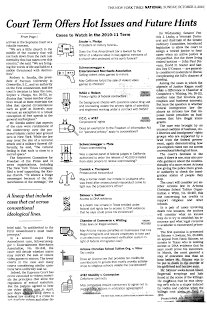
By Jessica R. Alexander, J.D., M.L.S., Reference Librarian
Students frequently mention their frustration with understanding legal concepts in their assigned cases. I always suggest that they try graphically depicting the facts and legal concepts in their cases. I was gratified Sunday to read the New York Times article, Supreme Court Term Offers Hot Issues and Future Hints, depicting the 2010-2011 United States Supreme Court Term in graphical images. (Click on the image for larger view.)
While briefing cases, a student may want to doodle the factual scenario. Resources are available on the utility of doodling in a learning situation. One web site features an article by Chris Dunmire, called "Exploring the New Wisdom of Doodling."
On a related note, I had a personal experience with the Texas Skinner v. Switzer case, No. 09–9000. It is set for oral argument on October 13, 2010. This case concerns whether a death row inmate has a right to DNA testing of evidence under the Civil Rights Act of 1871, codified at 42 U.S.C. 1983. The Times article mentions that Hank Skinner received a stay of his execution less than an hour before his scheduled execution. I was present at the execution vigil a block away from the execution chamber and was with a close friend of the inmate, the wife of a Pentecostal minister from West Texas, when his lawyer called her and told her of the stay. The news media rushed towards us when it was apparent from my screaming that we had heard good news. The whole scenario of being present at an execution vigil is surreal. For more information on the details of the case I recommend the information at http://www.excitatio.com/hankskinner/index.html. This site includes the full procedural history of the case and clemency applications with background and legal details.